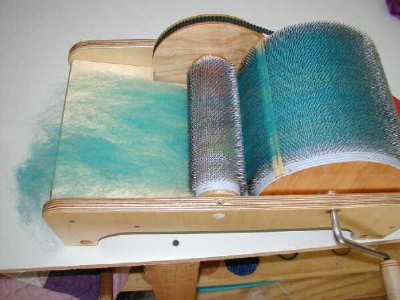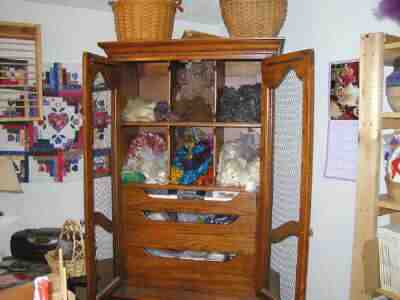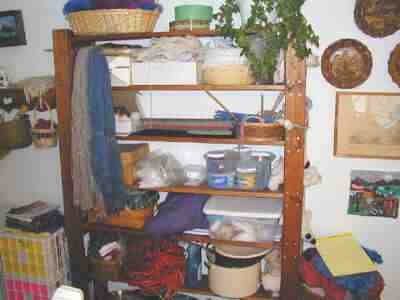Home
Studio
Teaching
Tutorials
Holly Shaltz, Fiberist
PO Box 136
Boyne City MI
49712 USA
phone:
(231) 582 3206
fax:
(231) 582 0426
email:
holly@hjsstudio.com
|
On the pages under this section of my website, you will find detailed information about what I create, how I create it, and how you can own one of my one-of-a-kind pieces yourself.
Each item is designed and made completely by me, or me working with you. I employ no one in my studio, nor do I send out piecework.
This is because I have a very high commitment to quality. I use processes that few other spinners would bother with because of the time they take. Methods like "precarding", which guarantees only the best quality wool will make it into my work. And my attention to detail, which includes such things as twisting the fringe to keep it from falling apart during use. See my Processes page for more information about how I make each project both beautiful and practical.
I also stand behind my products in offering cleaning and repair services. I can wash your special piece for you if needed, so you don't need to worry about its being harmed by dry cleaning or other laundering methods. I can also spin repair yarns and mend your damaged article if the worst should happen and a bug decides to lunch on it, or something sharp snags it. Call me to describe the problem and I will offer a rough estimate, with a final estimate after I have examined the item in person. There is a minimum charge of $25 for an estimate.
Whether you are buying an existing piece or commissioning a special project made to your specifications, you can rely on quality from HJS Studio. Once upon a time it was commonplace for special textiles to become cherished family heirlooms. Working together, we can create your family heirlooms.
A Virtual Tour of My Studio
|
I would like to invite you to step into my studio for a virtual tour. Here you'll see pictures of the place where I create my one-of-a-kind items, plan my classes, and do my research.
This is the view from my spinning window. I can look at the pines outside, watch the birds at the feeder, hear the chimes, feel the fresh breeze.....
well, OK, I don't open the windows much in the winter!
|

|
 |
In this picture, you can see my two spinning wheels. A spinning wheel is a device for inserting twist into fiber, to make yarn. The small, dark wheel is the one I use the most, and is my first wheel, an Ashford Traveler. I purchased this wheel in 1986, a few months after teaching myself how to spin on a homemade drop spindle. The large wheel against the window is a Rio Grande. I bought this wheel for spinning yarns that are highly textured, which are difficult to produce on the Traveler. For the "wheel" I use most often these days, see Electric Spinner photos.
|
Here is my small Mark V drum carder. Drumcarders prepare fiber for spinning. This carder is the one I finish my batts (yes, like quilt batts!) on before spinning. Pictured with the carder is a section of a layered batt, or rainbow batt, in the process of being carded a second time. You can see the layers of color in the batt. These colors spin into the yarn randomly, causing one of a kind effects in the yarn and the item made from the yarn. Wherever you see pieces on my site made with random color changes, this is the tool I use. |
 |
 |
This is my workhorse drumcarder, a Duncan double wide motorized carder. This is where I prepare fibers first, before taking them to the Mark V. I can also prepare layered batts on this carder, but I find the overall quality is better, and the batts are easier to handle, when finished on the Mark V. That means my spinning speed is faster, too. But the Duncan speeds up color and fiber blending when I need well-blended combinations. So it sees a lot of use! |
Now for my loom! I purchased this Harrisville 40 inch wide 8-shaft floor loom in 1988 as a kit. My husband and I assembled it in our living room. Because it is an 8 shaft floor loom, I have quite a bit of creative flexibility when choosing weave structures. In this picture it's buried in fiber waiting for processing into yarn that can be woven. |
 |
 |
This armoire, which belonged to my father, is where I store many of my exotic fibers. Tucked in with each little pile of lusciousness is a sachet of lavender and other traditional bug repelling herbs. No chemicals are used to moth proof my fibers. Here you can see bombyx silk, tussah silk, some of my angora, mohair, and llama and alpaca. What a treat to touch! | |
 |
On the left are my reference shelves, with the books I have collected over the years, along with more fiber (of course!) and color wheels, watercolor paints, colored pencils, etc, for helping me plan my approach to each piece I make. The shelves on which I store my dyepots is on the right. I hope to eventually have an outdoor dyeing shed, but for now my pots live in the studio, and I use them in my kitchen as needed. More fiber, woven samples, a simple knitting machine, and my dyes are on these shelves as well as the pots. |
 |
Finally, here's a panoramic view of my studio. You can just see a stained glass piece in the window, of tulips--it was made by my mother. There's lots of things here that I haven't described--you'll have to come for a visit to see it all :) |
 |
|




































